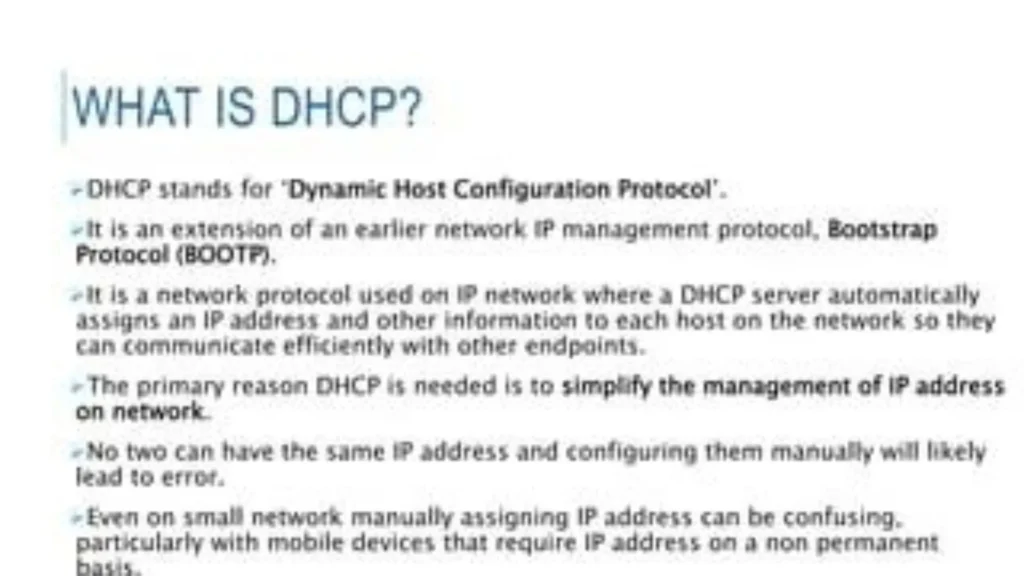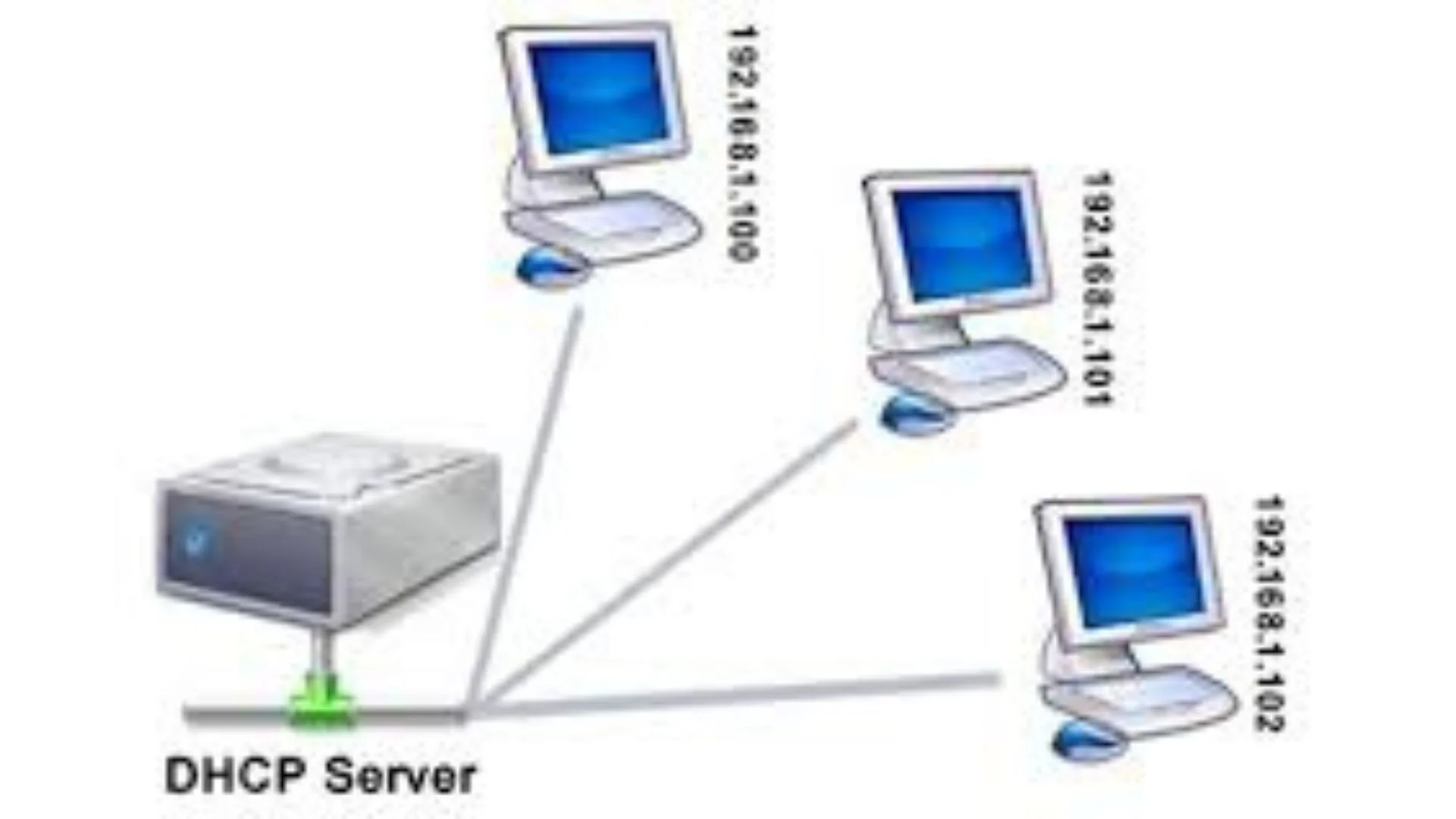Dynamic Host Configuration Protocol (DHCP) is a network management protocol
used to automate the process of configuring devices on IP networks.Understanding DHCP: Basics and Functionality
DHCP enables devices to automatically obtain IP addresses and other network configuration information, such as subnet mask, default gateway, and DNS servers, without manual intervention.
[H2] How DHCP Works
- DHCP Discovery: When a device (DHCP client) wants to join a network, it broadcasts a DHCP Discover message to find available DHCP servers.
- DHCP Offer: DHCP servers on the network respond to the DHCP Discover with a DHCP Offer, proposing an IP address and other configuration details to the client.
- DHCP Request: The client selects an offer and broadcasts a DHCP Request message, indicating its acceptance of the offered IP address and configuration.
- DHCP Acknowledgment: The chosen DHCP server responds with a DHCP Acknowledgment (DHCP Ack), confirming the allocation of the IP address and finalizing the configuration.
This automated process simplifies network management, especially in environments with numerous devices, by dynamically assigning IP addresses and ensuring efficient IP utilization.
[H2] Benefits of DHCP
- Automation and Scalability: DHCP automates IP address management, reducing administrative overhead and minimizing the risk of configuration errors,
especially in large networks. - Efficient IP Utilization: By dynamically allocating IP addresses,
DHCP ensures that IP addresses
are not wasted and can be reused,
optimizing network resources. - Simplified Device Mobility: DHCP supports mobile and temporary devices, enabling seamless network connectivity as devices move between networks.
[H1] DHCP Vulnerabilities and Fraud Risks
[H2] DHCP Spoofing
DHCP spoofing involves an attacker setting up a rogue DHCP server on a network.
This malicious server responds to DHCP Discover messages with fraudulent offers, redirecting clients to use the attacker’s IP settings. This can lead to various attacks, including:
- Man-in-the-Middle Attacks: The attacker can intercept and manipulate traffic between the client and legitimate servers, capturing sensitive information or injecting malicious data.
- Denial of Service (DoS): By assigning non-functional IP addresses or incorrect configuration information, the rogue server can disrupt network communication and prevent legitimate network access.Understanding DHCP: Basics and Functionality
[H2] DHCP Starvation Attacks
In a DHCP starvation attack, the attacker sends numerous DHCP Discover messages with spoofed MAC addresses to exhaust the pool of available IP addresses on the DHCP server. This prevents legitimate devices from obtaining IP addresses, causing network disruptions.
Such attacks can serve as a precursor to setting up a rogue DHCP server,
as legitimate devices cannot obtain IP addresses from the genuine server,
making them more likely to accept offers from a rogue server.
[H2] Information Leakage
DHCP transactions can reveal network configuration details, such as IP address ranges,
subnet masks, and DNS servers, which can be exploited
by attackers for reconnaissance purposes. Knowledge of these details can facilitate targeted attacks against network infrastructure or specific devices.Understanding DHCP: Basics and Functionality
[H2] Misconfiguration and Lack of Authentication
Misconfigured DHCP servers or clients can create vulnerabilities that attackers might exploit. For instance, if a DHCP server is configured to allocate IP addresses
from an incorrect range or without proper lease expiration,
it can lead to IP conflicts or depletion of address pools.
Additionally, traditional DHCP lacks robust authentication mechanisms, making it susceptible to unauthorized devices joining the network and potential abuse by malicious entities.Understanding DHCP: Basics and Functionality
[H2] DHCP Server Exploitation
Compromising a DHCP server can have far-reaching consequences. Attackers who gain control over a DHCP server can manipulate IP address assignments and network configurations,
redirecting traffic or launching broader attacks within the network.
This level of control can be used to conduct espionage,
data exfiltration, or disrupt network operations.
[H1] Case Studies: Real-World DHCP Exploits
[H2] Case Study 1: Network Disruption in a Corporate Environment
A rogue DHCP server was introduced into a corporate network,
causing widespread connectivity issues.
The rogue server provided incorrect network configuration details, leading to IP conflicts and network outages.Understanding DHCP: Basics and Functionality
Analysis: This incident underscores the importance of monitoring for unauthorized DHCP servers and implementing network segmentation to contain potential damage.
[H2] Case Study 2: Data Theft via Man-in-the-Middle Attack
An attacker set up a rogue DHCP server in a public Wi-Fi network. By assigning their own IP address as the default gateway, they intercepted and logged all traffic from connected devices, capturing sensitive information such as login credentials and personal data.
Analysis: This example highlights the risks of untrusted networks and the need for secure communication channels, such as VPNs, especially when using public Wi-Fi.
[H2] Case Study 3: Denial of Service in Educational Institutions
A DHCP starvation attack was launched in a
university network during exam periods,
preventing students from accessing online exams and resources.
The attack involved sending a flood of DHCP Discover messages from spoofed MAC addresses, exhausting the DHCP server’s IP address pool.
Analysis: This case demonstrates the potential impact of DHCP starvation attacks on service availability and the importance of robust DHCP server configurations and monitoring.
[H1] Mitigating DHCP Fraud Risks
[H2] Implementing DHCP Snooping
DHCP snooping is a security feature that acts as a firewall between untrusted hosts and DHCP servers. It filters DHCP messages and helps prevent rogue DHCP servers and starvation attacks by:
- Validating DHCP Messages: DHCP snooping checks the origin of DHCP messages, ensuring that only trusted servers respond to clients.
- Maintaining a Binding Table: It keeps a table of valid IP-to-MAC address bindings, preventing attackers from using spoofed addresses.
- Blocking Untrusted Ports: Ports not designated for trusted DHCP server communication
are blocked from sending DHCP Offer or Ack messages.
[H2] Network Segmentation and Access Control
- Segmentation: Dividing the network into smaller segments or VLANs can limit the spread of potential attacks. Each segment can be managed with its own DHCP server,
reducing the impact of any single compromised server. - Access Control Lists (ACLs): Implementing ACLs can restrict which devices can communicate with the DHCP server,
preventing unauthorized devices from participating in the DHCP process.
Using Secure DHCP Options
- DHCP Authentication: While traditional DHCP does not include robust authentication mechanisms, some implementations support DHCP authentication extensions. These can help verify the identity of clients and servers, reducing the risk of unauthorized access.
- IP Address Management (IPAM): IPAM tools provide centralized management of IP address allocation, offering better oversight and control over DHCP operations and reducing the risk of misconfiguration.
Regular Monitoring and Logging
- Network Monitoring: Continuous monitoring of network traffic can help detect unusual DHCP activity, such as a sudden increase in DHCP Discover messages
or the presence of unauthorized DHCP servers. - Logging and Alerts: Keeping detailed logs of DHCP transactions and setting up alerts for suspicious activities can aid in the early detection and response to potential DHCP-related threats.
Education and Awareness
Educating network administrators and users about DHCP risks and best practices is crucial. Awareness programs can include:
- Training for IT Staff: Ensuring that network administrators understand DHCP security features, proper configuration techniques, and incident response protocols.
- User Awareness: Informing users about the risks of connecting to untrusted networks and the importance of using secure connections,
such as VPNs, when accessing sensitive information.
Future Trends and Technologies in DHCP Security
Advancements in DHCP Security Protocols
Future developments in DHCP security protocols may include enhanced authentication mechanisms and encryption options to safeguard DHCP transactions.
Such advancements could reduce the risk of unauthorized access and manipulation of DHCP communications.
Integration with Next-Generation Network Security
As networks evolve with technologies like Software-Defined Networking (SDN) and Network Functions Virtualization (NFV),
DHCP security can be integrated into broader security frameworks.
This integration can provide more granular control and visibility over DHCP operations and potential threats.
AI and Machine Learning for Threat Detection
Artificial Intelligence (AI) and Machine Learning (ML) can be leveraged
to analyze DHCP traffic patterns and detect anomalies indicative of fraud or attacks.
These technologies can enhance the ability to identify and respond to threats in real-time,
improving the overall security posture of DHCP-enabled networks.
Zero Trust Architecture
Implementing a Zero Trust security model,
where no device or user is inherently trusted,
can further enhance DHCP security.
In this model, continuous verification of all devices and users is required,
reducing the risk of unauthorized access and fraud.

Conclusion
DHCP is an essential component of modern networking, providing automated and efficient IP address management. However, it is also a potential vector for fraud and cyberattacks.
Understanding the vulnerabilities associated with DHCP and implementing robust security measures is crucial to mitigating these risks.
By adopting best practices such as DHCP snooping, network segmentation,
secure DHCP options, and continuous monitoring,
organizations can protect their networks from DHCP-related threats.
Future advancements in DHCP security protocols,
integration with next-generation network security,
and the application of AI and Zero Trust models offer promising avenues for enhancing DHCP security

